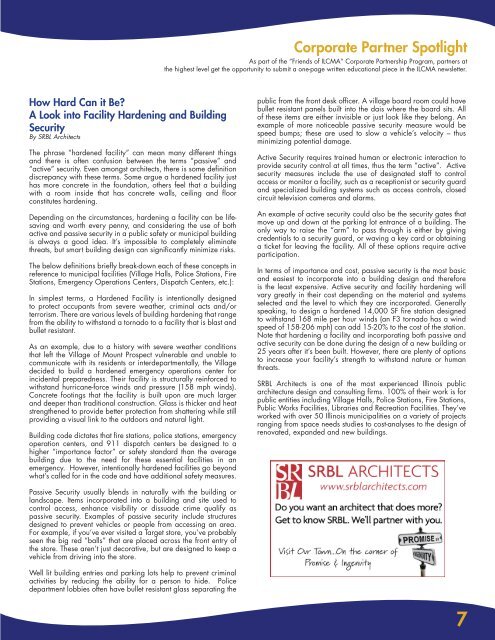December 2011 Newsletter.pdf - ILCMA
December 2011 Newsletter.pdf - ILCMA
December 2011 Newsletter.pdf - ILCMA
You also want an ePaper? Increase the reach of your titles
YUMPU automatically turns print PDFs into web optimized ePapers that Google loves.
Corporate Partner SpotlightAs part of the “Friends of <strong>ILCMA</strong>” Corporate Partnership Program, partners atthe highest level get the opportunity to submit a one-page written educational piece in the <strong>ILCMA</strong> newsletter.How Hard Can it Be?A Look into Facility Hardening and BuildingSecurityBy SRBL ArchitectsThe phrase “hardened facility” can mean many different thingsand there is often confusion between the terms “passive” and“active” security. Even amongst architects, there is some definitiondiscrepancy with these terms. Some argue a hardened facility justhas more concrete in the foundation, others feel that a buildingwith a room inside that has concrete walls, ceiling and floorconstitutes hardening.Depending on the circumstances, hardening a facility can be lifesavingand worth every penny, and considering the use of bothactive and passive security in a public safety or municipal buildingis always a good idea. It’s impossible to completely eliminatethreats, but smart building design can significantly minimize risks.The below definitions briefly break-down each of these concepts inreference to municipal facilities (Village Halls, Police Stations, FireStations, Emergency Operations Centers, Dispatch Centers, etc.):In simplest terms, a Hardened Facility is intentionally designedto protect occupants from severe weather, criminal acts and/orterrorism. There are various levels of building hardening that rangefrom the ability to withstand a tornado to a facility that is blast andbullet resistant.As an example, due to a history with severe weather conditionsthat left the Village of Mount Prospect vulnerable and unable tocommunicate with its residents or interdepartmentally, the Villagedecided to build a hardened emergency operations center forincidental preparedness. Their facility is structurally reinforced towithstand hurricane-force winds and pressure (158 mph winds).Concrete footings that the facility is built upon are much largerand deeper than traditional construction. Glass is thicker and heatstrengthened to provide better protection from shattering while stillproviding a visual link to the outdoors and natural light.Building code dictates that fire stations, police stations, emergencyoperation centers, and 911 dispatch centers be designed to ahigher “importance factor” or safety standard than the averagebuilding due to the need for these essential facilities in anemergency. However, intentionally hardened facilities go beyondwhat’s called for in the code and have additional safety measures.public from the front desk officer. A village board room could havebullet resistant panels built into the dais where the board sits. Allof these items are either invisible or just look like they belong. Anexample of more noticeable passive security measure would bespeed bumps; these are used to slow a vehicle’s velocity – thusminimizing potential damage.Active Security requires trained human or electronic interaction toprovide security control at all times, thus the term “active”. Activesecurity measures include the use of designated staff to controlaccess or monitor a facility, such as a receptionist or security guardand specialized building systems such as access controls, closedcircuit television cameras and alarms.An example of active security could also be the security gates thatmove up and down at the parking lot entrance of a building. Theonly way to raise the “arm” to pass through is either by givingcredentials to a security guard, or waving a key card or obtaininga ticket for leaving the facility. All of these options require activeparticipation.In terms of importance and cost, passive security is the most basicand easiest to incorporate into a building design and thereforeis the least expensive. Active security and facility hardening willvary greatly in their cost depending on the material and systemsselected and the level to which they are incorporated. Generallyspeaking, to design a hardened 14,000 SF fire station designedto withstand 168 mile per hour winds (an F3 tornado has a windspeed of 158-206 mph) can add 15-20% to the cost of the station.Note that hardening a facility and incorporating both passive andactive security can be done during the design of a new building or25 years after it’s been built. However, there are plenty of optionsto increase your facility’s strength to withstand nature or humanthreats.SRBL Architects is one of the most experienced Illinois publicarchitecture design and consulting firms. 100% of their work is forpublic entities including Village Halls, Police Stations, Fire Stations,Public Works Facilities, Libraries and Recreation Facilities. They’veworked with over 50 Illinois municipalities on a variety of projectsranging from space needs studies to cost-analyses to the design ofrenovated, expanded and new buildings.Passive Security usually blends in naturally with the building orlandscape. Items incorporated into a building and site used tocontrol access, enhance visibility or dissuade crime qualify aspassive security. Examples of passive security include structuresdesigned to prevent vehicles or people from accessing an area.For example, if you’ve ever visited a Target store, you’ve probablyseen the big red “balls” that are placed across the front entry ofthe store. These aren’t just decorative, but are designed to keep avehicle from driving into the store.Well lit building entries and parking lots help to prevent criminalactivities by reducing the ability for a person to hide. Policedepartment lobbies often have bullet resistant glass separating the7


